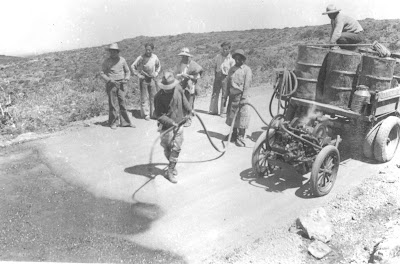The first time I ever heard about building roads with tar & dirt was the first time I ever visited Chester (Chet)'s model railroad. Like many of his generation (the "Greatest") he had a 4x8 in his basement and spent his retirement years working on it, bit by bit. One of the things he enjoyed most was recreating scenes from his younger years. One of those scenes was the scene above, taken during the summer of 1985 with my Kodak Instamatic. It depicts a road crew, using a truck to pour on the tar and two guys shoveling dirt onto it. Chet enjoyed telling the story of how roads were built when he was growing up, and how fascinated he was every summer he saw the crews out building a new road, or maintaining an old one.
Curiously, I couldn't find much about this process on the internet. I found the photo above, and I found a cool article from the August 1920 issue of "The Road-Maker, Excavator and Grader" magazine (a pretty cool read, actually). But Chet's word was certainly more than enough - and the mini-scene on his layout depicted the process nicely.
So, when it came time to work again on Fernwood Street in Wethersfield (click here and here for the previous posts on Fernwood), I again consulted my primary source photo:

John Wallace took this photo of the southbound Valley Local from his bedroom window sometime during the early 1940s. Fernwood is a dead-end street that ends at the railroad tracks. But most interestingly, it looks to ME at least like this is a tar/dirt road.
I fear John may contradict me with actual prototype information (always a risk), but it sure looks the part - and this method of cheap road construction would certainly make sense on a dead-end street, especially during the 1940s.
So, after a famously failed experiment attempting a "concrete" Fernwood Street, I decided to pay homage to Chet's story and try a "tar & dirt" road here.
The pic above shows where I started. I "capped" the failed ground good/masonite base for the concrete patch road with a sheet of .060" styrene sheet. The two pieces of cardboard on top of that define the limits of the street and provide an elevated base for the yards/houses.
Step 1: After "damming" the fascia end of the road with masking tape, I applied a thick coat of flat black paint on the road surface.
Step 2: Next, I sifted on a thick layer of my finest grade dirt using a spoon.
Step 3: After waiting overnight for everything to dry, I used a soft brush to brush the excess dirt into a pile to scoop it up with my spoon (dirt may be "dirt cheap" but there's no need to waste it!). I brushed lengthwise along the road, following the direction of traffic (such as it is on a dead-end road).
Step 4: I vacuumed up any remaining excess with my ShopVac, which really made the road "pop" and look like some of the dirt had worn off and the tar soaked through.
Super easy, and a great effect - if I don't say so myself.
The thick black paint (aka "tar") acts as the adhesive - similar to the prototype. The one thing I might try to do differently next time is add some wheel ruts after adding the dirt, but before everything dries. I just don't know 1) whether the paint is really thick enough for that, and 2) whether that would just tend to make black lines rather than ruts.
Then again, according to the article, one of the benefits of this type of road construction is that it creates a (relatively) hard surface. So maybe ruts aren't needed.
One thing that's definitely no longer needed is a road surface for Fernwood Street! I'm pretty happy how nice this came out - and how easy it was to do. I hope you try this technique yourself - and if you do, let us know in the comments!








It was a common thing to see on early neighborhood streets (late 40's early 50's) maybe look up "early asphalt paving machines" or Barber Green paving, the sand was thrown in a fanning motion, not dropped to get a even spread
ReplyDeleteHi Chris:
ReplyDeleteGreat looking tar road...will have to try that as it seems to be an easy addition for a layout...George
Looks good Chris. I can remember in the '50's we had may gravel roads in our community. Every spring once the roads dried out the city works department would come around with a tanker and spray the roads with a black oily spray to keep the dust down.
ReplyDeleteI remember seeing this paving process at a relatives house in South Salem, NY in the mid 50's. As Eddie described sand was fanned from shovels by workers in the back of a dump truck after tar was first sprayed from a tank truck.
ReplyDelete